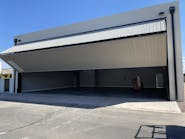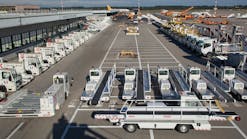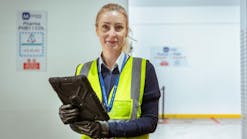$230M in Projects at Bradley International Airport Anticipate Passenger Growth
In anticipation of future air travel growth, Bradley International Airport is embarking on two major projects that will cost nearly $230 million aimed at transforming the airport’s terminal and making room for more airlines, passengers and amenities.
The state’s largest commercial airport will construct a system that will transport checked baggage along a mile-long network of conveyor belts to a new building near the Sheraton hotel for security screening. The $185 million project will remove baggage screening from the terminal lobby, freeing up space for at least 16 new airline ticket counters.
Bradley checks about 2 million bags a year, not counting carry-ons.
A companion, $42 million project will include additions to the east and west sides of the terminal. New sets of escalators and elevators will connect the concourse and baggage claim, also creating new lounge areas for people waiting for travelers arriving at the airport.
The idea is to relieve the congestion on the one central stairwell that now serves all passengers. The central stairwell will eventually be eliminated, opening up more space for travelers standing in line at the nearby passenger screening checkpoint. At heavy travel periods, the line often spills out into the lobby.
Kevin Dillon, executive director of the Connecticut Airport Authority, which oversees Bradley’s operations, said the projects will help absorb expected airline and passenger growth in the coming years, putting off the need to build a second terminal.
“I do think, in Bradley’s future, a second terminal is inevitable, but we want to push that out as far as we can for obvious financial reasons,” Dillon said. “A new terminal building, you’re talking in excess of a billion dollars.”
Experts say screening baggage in airport lobbies was a gut reaction after 9/11. In the past decade, however, screening has largely been moved out of airport lobbies, with air travelers expecting to hand off luggage to ticket counter agents for screening elsewhere, they say.
“There’s just something [psychological] about seeing the bag on the belt,” Ty Orbaugh, global director of aviation at San Francisco-based architectural firm Gensler, which designs airport projects, said. “I think you feel it’s going to get where it needs to get to. There’s a level of safety there.”
Similarly, more airports are looking at passenger “circulation” projects like the two additions at either end of the terminal at Bradley, Orbaugh said. There’s a growing emphasis on making it easier to get around, whether on foot, in a wheelchair or on crutches, Orbaugh said.
“The more opportunities you give passengers to move freely — it’s a much safer environment,” Orbaugh said.
At Bradley, the projects are expected to be finished in the next two to three years.
Construction will begin this fall and kicks off just months after Bradley cut the ribbon on its new, $210 million ground transportation center. The transportation center consolidated all rental car companies in one place and added more parking — all connected to the terminal.
The largest chunk of combined financing for the two new projects — $104 million — is expected to come from airport reserves and borrowing through the sale of bonds. Those bonds would be repaid by revenues generated by the airport.
Federal airport grants of about $40 million — including a $20 million competitive grant awarded this summer from the federal infrastructure legislation — and about $45 million from the Transportation Security Administration, which handles the baggage screening, are part of the funding package.
The final piece of financing, about $38 million, is expected to come from passenger facility charges. Those charges, up to $4.50 per passenger boarding an aircraft, are allowed at airports such as Bradley that are controlled by public agencies.
Uncertain time in air travel
The launch of the two improvement projects, however, comes at an uncertain time in air travel market nationally and in Connecticut.
At Bradley, leisure travel surged this summer, but business travel, which represented half of Bradley’s passengers before the pandemic, continues to lag.
Experts have said air travel for meetings within companies may largely be lost to Zoom for good, but meetings with clients are likely to pick up again.
The big-ticket projects at Bradley also coincide with the emergence of the once-sleepy backwater of Tweed-New Haven Airport as a competitor. Tweed, which isn’t overseen by the CAA, now offers some of the same routes as Bradley, particularly leisure flights to Florida on Avelo Airlines.
Air travelers arriving and departing Bradley plunged in the pandemic to 2.4 million, from 6.75 million in 2019, according to statistics from the CAA. In 2021, Bradley logged 4.6 million passengers.
Dillon said annual air passenger counts appear to be on pace to recover to pre-pandemic levels by 2023, and, despite uncertainty, he is optimistic about future growth. This year, Bradley has seen the expansion of routes, particularly with low-cost carrier Breeze Airways. Breeze also is making Bradley an operations hub.
Dillon said he is keeping his eye on the variables of business travel and Tweed’s expansion as well as airlines nationally adjusting the number of flights, responding to staff shortages.
“You have to factor that into some of the decisions that we make,” Dillon said. “With these two projects, we believe, we’re behind the times, and it needs to be done. Some of things that we are doing now, we’re playing catch-up.”
‘Behemoths in the lobby’
On a recent afternoon, Dillon and the CAA’s director of engineering and planning, Bob Bruno, walk through the airport lobby, passing the baggage screening machines.
“I feel very comfortable saying this: Bradley is one of the last airports in the country where you have these behemoths in the lobby,” Dillon said. “As you can see, each of these machines is very labor intensive, feeding the bag in.”
With the new system, luggage will be sent to screening via the conveyor system at the ticket counter. Passengers won’t have to take the separate step of bringing them to the screening machines in the lobby.
The screening will take place on the lower level of the new 80,000-square-foot building tucked in behind the back of the hotel. An upper level is expected to be used for future gate expansion, essentially the beginning of a second terminal that could be built on where the now-demolished Murphy terminal once stood. A “mezzanine” above that may be used for offices and mechanical equipment.
The screening project is being paired with two additions of 10,000 square feet each on the west and east ends of the terminal anticipating passenger growth and easing congestion between the concourse and baggage claim.
Both will be equipped with areas designated for people waiting to meet arriving passengers. Now, those people often wait at the top of the existing central stairwell, adding to the area’s congestion.
On the east end, there will be space to expand and add another entrance to the popular Escape Lounge and another concession, Bruno said.
On the opposite end of the terminal, there is a tighter fit because the Sheraton is so close, but access off the addition to the hotel is planned.
“It’s going to transform the building,” Bruno said. “Maybe it’s not as dramatic as the ground transportation center, but it will be a dramatic difference for passengers in terms of how they come and go.”
Kenneth R. Gosselin can be reached at [email protected].
©2022 Hartford Courant. Visit courant.com. Distributed by Tribune Content Agency, LLC.



